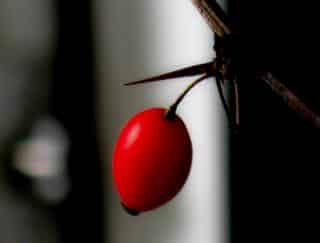Although often grown as an outdoor hedge, it’s possible to grow a small barberry shrub inside. Simple care and a few smart tips will help grow a cute indoor barberry for quite a few years!
Indoor barberry tips
Exposure – well-lit
Soil type – well-draining
Care type – bonsai care
Winter care – trigger dormancy
Barberry is often thorny. Place your barberry in a place where nobody needs to go! A shelf or well-lit corner is perfect.
How to pot your barberry for indoor growing
Best type of pots & soil to grow barberry indoors
When the shrub is still a small seedling, plant it in a pot that drains well.
- Berberis in the open can cope with many different types of soil, even those that are occasionally waterlogged. However, when in pots, it’s best to avoid wet soil.
- Since many plants are often overwatered, it’s important to make sure it drains well.
If you must use a saucer under the pot to protect furniture or carpets, take the following precautions:
- Pour a layer of clay pebbles in the saucer and rest the pot on top of it: excess water will drain out.
- After watering, drain any excess water out from the saucer.
Repotting indoor barberry
Your indoor barberry will need pruning for it to stay small, and repotting, too.
Repotting has three functions:
- it replenishes nutrients
- roots are given more space to grow
- longer roots are cut short to keep the plant from getting rootbound.
Every year, check whether roots are emerging from the holes. This is a sure sign you need to repot. If none, repot every two or three years.
- You might want to use plastic pots and then place the plastic pot inside a nicer-looking ornamental pot.
- The plastic pot makes for easier repotting, since you can cut it open if ever roots have grown out through the holes.
Indoor barberry care
Exposure
Barberry can take low light, but it will thrive most in high light. Place it near a window that faces towards the equator:
- South-facing for North America and Europe
- North-facing for South America, Australia, India, Indonesia and Africa
Don’t let it dry out though.
- Keep it away from direct sun. A thin veil or curtain is perfect when near a window.
- Avoid sources of heat like radiators.
- If near a hot, dry spot, make sure it doesn’t dry out.
Watering
Water whenever the soil is dry.
- In spring, summer, and fall, this will be about once a week.
- In winter, water only every fortnight, especially during the dormant period.
Pruning
Prune yearly, right after the blooming.
Just like a Ficus ginseng, you’ll have to prune it regularly to make it branch out evenly. It might not bloom or bear fruit, though.
- Cutting the branches short will help the shrub branch out more.
- Berberis can take severe pruning, so feel free to cut back hard if need be.
You can try to keep a few fruits on the plant, they will turn into beautiful berries.
- Smart tip: when pruning, feel free to cut off thorns that are too sharp. This won’t hurt the plant, and the plant won’t hurt you!
Winter care and triggering dormancy on an indoor Berberis
It’s important for barberry (Berberis is the scientific name) to have some seasonality.
- This means it should be made to feel the difference between summer and winter.
- This doesn’t happen naturally in a house or apartment.
- Dormancy is important to promote blooming, develop roots, and prepare spring vegetation.
How to trigger dormancy
The preparation needn’t be as dramatic as that required to rebloom a Poinsettia. Nonetheless, here are the key takeaways:
- reduce light – take the plant to a darker room, hallway, cellar, basement or attic with low light.
- reduce temperatures – if the above place is significantly cooler than the rest of the house, even better.
- Aim for around 50-60°F (10-15°C), and around 12 to 14 hours of darkness.
- Do this for 6 to 8 weeks.
- An alternative is simply to put the pot outside on a terrace or balcony for two good months.
Ideal is a lean-in or veranda that isn’t heated, or a cold greenhouse. Try putting it in a winter garden, or transfer it to a dark, cool pantry for around two months.
Normally, leaf growth should stop.
- It’s ok if it freezes lightly (upper 20s Fahrenheit or -5°C).
- For deciduous barberries, leaves may drop. This is normal.
- On evergreen barberries, a few more leaves than usual may drop, but not necessarily.
Best varieties for indoor growing
 Mostly, smaller and slow-growing Berberis varieties are best.
Mostly, smaller and slow-growing Berberis varieties are best.
- Check out our page describing dwarf barberry
- They naturally grow slower and smaller than other taller varieties.
If you want to grow them indoors, however, it’s recommended to make sure of the following:
- perhaps select a variety that doesn’t have any thorns. Since it would be inside, clothing or soft hands might get a scratching!
- The variety called ‘Thornless’ doesn’t have any thorns, but it tends to grow tall (5 feet or 1.8 meters). You’ll have to prune it often to keep it small.
Specialists that love bonsai have succeeded in preparing wonderful potted Berberis bonsai.
- These require regular pruning and shaping, though, since they tend to grow vigorously.
- Read more about growing Barberry bonsai
Smart tip about growing Berberis indoors
Whenever the weather permits, bring the pot outside! This will help fight against pests. Aphids, mites and scale insects can’t take hot and cold variations, whereas the berberis can!


 Mostly, smaller and slow-growing Berberis varieties are best.
Mostly, smaller and slow-growing Berberis varieties are best.